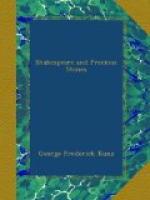Moreover, we have a simile which might almost make us suppose that Shakespeare knew something of the details of the pearl fisheries, when the oysters are piled up on shore and allowed to decompose, so as to render it easier to get at the pearls, for he makes one of his characters say, speaking of an honest man in a poor dwelling, that he was like a “pearl in your foul oyster”. (As You Like It, Act v, sc. 4.)
In the strange transformation told of in Ariel’s song, the bones of the drowned man have been turned to coral, and his eyes to pearls (Tempest, Act i, sc. 2). The strange and sometimes morbid attraction of opposites finds expression in a queer old English proverbial saying given in the Two Gentlemen of Verona: “Black men are pearls in beauteous ladies’ eyes”. The likeness to drops of dew appears where we read of the dew that it was “Decking with liquid pearl the bladed grass” (Midsummer Night’s Dream, Act i, sc. 1), and a little later in the same play we read the following injunction:
I most go seek
some dewdrops here
And hang a pearl
in every cowslip’s ear.
Midsummer
Night’s Dream, Act ii, sc. 1.
First
Folio, “Comedies”, p. 148, col. A,
line 38.
And later still we have the lines:
That same dew, which sometime
on the buds
Was wont to swell like round and orient pearls.
Midsummer Night’s Dream,
Act iv, sc. 1.
“Comedies”, p. 157,
col. B, line 10.
The pearl as a simile for great and transcendent value, perhaps suggested by the Pearl of Great Price of the Gospel, is used of Helen of Greece in the lines (Troilus and Cressida, Act ii, sc. 2):
She is a pearl
Whose price hath launch’d above a thousand
ships.
At end of “Histories”,
page unnumbered
(p. 596 of facsimile), Col.
A, line 19.
This being an allusion to the Greek fleet sent out under Agamemnon and Menelaus to bring back the truant wife from Troy. The idea of a supremely valuable pearl is also apparent in the lines embraced in Othello’s last words before his self-immolation as an expiation of the murder of Desdemona, where he says of himself:[1]
Whose hand
Like the base Indian, threw a pearl away
Richer than all his tribe.
Othello, Act
v, sc. 2.
“Tragedies”, p. 338,
col. B, line 53.
[Footnote 1: For a Venetian tale that may have suggested these lines to Shakespeare, see the present writer’s “The Magic of Jewels and Charms”, Philadelphia and London, 1915, p. 393. The text of the First Folio gives “Iudean”, instead of “Indian".]
Although the term “Orient pearl” is that used by Shakespeare, and undoubtedly many of the older pearls of his day were really of Cinghalese or Persian origin, the principal source of supply was then the Panama fishery discovered by the Spaniards about a century earlier and actively exploited by them.[2] However, through the old inventories made by experts familiar with the real sources of precious stones and pearls—though not always correctly with those of the latter—the term “Orient pearl” came in time to denote one of fine hue, so that the “orient” of a pearl is still spoken of as signifying a sheen of the first quality.




